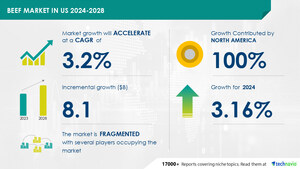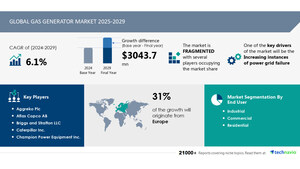NEW YORK, March 26, 2024 /PRNewswire/ -- The global commercial water heaters market size is experiencing a significant upsurge, projected to reach a value of USD 3.06 billion with a Compound Annual Growth Rate (CAGR) of 5.25% between 2022 and 2027. This forecasted growth is attributed to several factors including increasing demand from the hospitality sector, technological advancements in commercial water heating equipment, and government initiatives promoting energy-efficient heating solutions.
For more insights on the historic data (2017 to 2021) and forecast market size (2023 to 2027) - Request a sample report
One of the key drivers of this growth is the rising demand from the hospitality sector, where water heaters are essential for numerous applications such as bathing, cleaning, and cooking. With establishments like hotels, hospitals, and airports requiring large amounts of hot water, the adoption of commercial water heaters is witnessing a significant surge. Moreover, the energy savings achieved in commercial facilities are higher compared to residential buildings, making them an attractive investment for businesses.
Innovation in commercial water heating technology, particularly in the electric water heater segment, is another contributing factor to market growth. Despite being at a maturity stage, ongoing innovations such as tankless or instantaneous products have revitalized the market. Electric water heaters offer advantages such as lower maintenance costs compared to gas heaters, flexibility in installation, and suitability for commercial spaces with space constraints. These factors have led to increased adoption, especially in commercial buildings.
For more insights on the historic data (2017 to 2021) and forecast market size (2023 to 2027) - Request a sample report
A notable trend in the market is the increasing demand for hybrid devices, also known as heat pump water heaters. These devices utilize various energy sources including solar, propane, oil, and electricity for heating water. Hybrid devices overcome the limitations of conventional gas and solar water heaters by offering higher energy efficiency and features such as timer mode, contributing to energy savings.
However, the market also faces challenges, particularly related to technical issues associated with products such as limited lifespan and the risk of explosions in gas equipment. Governments around the world are imposing strict guidelines on the production of gas and propane water heaters to mitigate the risk of explosions, which could impact sales and revenues of key vendors.
For more insights on the historic data (2017 to 2021) and forecast market size (2023 to 2027) - Request a sample report
In terms of market segmentation, the Asia-Pacific (APAC) region is expected to contribute significantly to market growth, driven by infrastructure spending on commercial projects and the rise of smart city initiatives. Countries like India are investing heavily in infrastructure projects, leading to increased demand for water heaters. Additionally, smart city projects in Asia are contributing to the growth of the commercial real estate sector, further augmenting demand for commercial water heaters.
Key market players in the commercial water heater market include Solahart Industries Pty Ltd., Daikin Industries Ltd., Electric Heater Co., Ferroli Spa, and others. These companies are implementing various strategies such as strategic alliances, partnerships, mergers and acquisitions, and product/service launches to enhance their presence in the market.
For more insights on the historic data (2017 to 2021) and forecast market size (2023 to 2027) - Request a sample report
In conclusion, the global commercial water heater market is experiencing robust growth driven by increasing demand from the hospitality sector, technological innovations, and government initiatives promoting energy efficiency. Despite challenges related to technical issues, the market is poised for continued expansion, particularly in regions like Asia-Pacific. Key market players are actively pursuing strategies to capitalize on emerging opportunities and strengthen their market position.
Analyst Review
The commercial water heaters market is experiencing significant growth, driven by rising hot water demand in residential applications, fueled by factors such as population growth, urbanization, and changing lifestyles. Consumers are increasingly aware of the environmental impact of traditional water heaters and are seeking energy-efficient and sustainable options.
Innovative product offerings are emerging to meet this demand, ranging from traditional tank-style heaters to energy-efficient options like heat pump and solar water heating systems. As the market matures, the pace of growth accelerates, leading to heightened competition among manufacturers.
Technologies used for water heaters vary, including combustion fuels for traditional heaters and renewable sources like solar for sustainable options. Commercial water heaters cater to various sectors such as public buildings, offices, motels, commercial laundries, and industrial processes.
Regions like Mexico City, Kuwait, and Massachusetts are witnessing a surge in demand for commercial water heaters, driven by factors like greenhouse gas emissions reduction goals and energy-saving policies. The transition towards electrification is also impacting the market, with a focus on reducing CO2 emissions.
Key players in the market, such as Rinnai Corporation, offer a range of options including tankless heaters and gas-powered units. Installation costs, lifetime costs, and operating costs are significant considerations for consumers, alongside factors such as standby losses and cooling load.
Government incentives such as capital subsidies and consumer grants are promoting the adoption of energy-efficient systems, contributing to market growth. Mandates for higher efficiency and individual metering further drive the penetration of energy-efficient equipment.
Commercial water heaters play a crucial role in reducing electricity bills for businesses while aligning with regulatory norms and policies aimed at reducing the carbon footprint. They are integral to green building projects and comply with building codes and standards.
Technological advancements are enhancing the efficiency and functionality of commercial water heaters, with features such as integrated remote monitoring and automatic control systems. These systems cater to various applications, including bathing, cleaning, and cooking, ensuring a steady supply of hot water while minimizing energy consumption.
In conclusion, the commercial water heaters market is witnessing robust growth driven by rising demand, energy efficiency initiatives, and technological innovations. With a focus on sustainability and efficiency, the market is poised for further expansion in the coming years.
For more insights on the historic data (2017 to 2021) and forecast market size (2023 to 2027) - Request a sample report
Market Overview
The Commercial Water Heaters Market is experiencing a surge in demand due to several factors. Rapid urbanization and changing lifestyles have escalated the need for hot water in residential applications, especially for washing purposes. With the growing population, consumers are increasingly aware of the environmental impact of traditional water heaters and are seeking energy-efficient and sustainable options. As a result, innovative product offerings have emerged in the market, catering to this demand. The market is in a stage of rapid growth, driven by the pace of urbanization and consumer preference for eco-friendly solutions. From traditional water heaters to energy-efficient and sustainable options, the commercial water heaters market is witnessing a significant shift towards innovation and sustainability to meet the evolving needs of consumers.
For more insights on the historic data (2017 to 2021) and forecast market size (2023 to 2027) - Request a sample report
Related Reports:
- The heat pump water heater market is estimated to grow at a CAGR of 24.07% between 2022 and 2027. The size of the market is forecast to increase by USD 7,218.42 million. The advantages of heat pump water heaters are notably driving the market growth, although factors such as the lack of awareness may impede the market growth.
- The commercial bain-marie heaters market is projected to grow by USD 35.41 million with a CAGR of 5.8% during the forecast period 2021 to 2026. The focus on cooking consistency in food service establishments is notably driving the commercial bain-marie heaters market growth, although factors such as threat from substitute food service equipment may impede market growth.
Table of Contents
1 Executive Summary
2 Landscape
3 Sizing
4 Historic Size
5 Five Forces Analysis
6 Segmentations
7 Customer Landscape
8 Geographic Landscape
9 Drivers, Challenges, and Trends
10 Vendor Landscape
11 Vendor Analysis
12 Appendix
About US
Technavio is a leading global technology research and advisory company. Their research and analysis focuses on emerging market trends and provides actionable insights to help businesses identify market opportunities and develop effective strategies to optimize their market positions. With over 500 specialized analysts, Technavio's report library consists of more than 17,000 reports and counting, covering 800 technologies, spanning across 50 countries. Their client base consists of enterprises of all sizes, including more than 100 Fortune 500 companies. This growing client base relies on Technavio's comprehensive coverage, extensive research, and actionable market insights to identify opportunities in existing and potential markets and assess their competitive positions within changing market scenarios.
Contact
Technavio Research
Jesse Maida
Media & Marketing Executive
US: +1 844 364 1100
UK: +44 203 893 3200
Email: [email protected]
Website: www.technavio.com/
SOURCE Technavio

WANT YOUR COMPANY'S NEWS FEATURED ON PRNEWSWIRE.COM?
Newsrooms &
Influencers
Digital Media
Outlets
Journalists
Opted In






Share this article